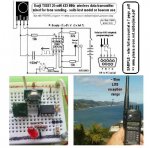Interesting new 433 MHz ASK modules
- Thread starter manuka
- Start date
Please correct me if I am wrong here ......
The formula came from FCC Web Site. I did the math.
Effective Isotropic Radiated Power
Formula: eirp = pt x gt = (E x d)^2 /30
Definitions:
pt = transmitter output power in watts,
gt = numeric gain of the transmitting antenna
E = electric field strength in V/m,
d = measurement distance in meters (m).
eirp = pt x gt = (E x d)^2 / 30
Given:
E = 5000uv per meter
d = 3 meters
gt = 1 (assuming an antenna gain of 1)
5000uv x 3 = 15000uv = 15mv
15mv ^2 = 225mv = .225v
pt = .225 / 30 = .0075 watts = 7.5mw
7.5mw = 8.75 dBm (Online calculator)
The formula came from FCC Web Site. I did the math.
Effective Isotropic Radiated Power
Formula: eirp = pt x gt = (E x d)^2 /30
Definitions:
pt = transmitter output power in watts,
gt = numeric gain of the transmitting antenna
E = electric field strength in V/m,
d = measurement distance in meters (m).
eirp = pt x gt = (E x d)^2 / 30
Given:
E = 5000uv per meter
d = 3 meters
gt = 1 (assuming an antenna gain of 1)
5000uv x 3 = 15000uv = 15mv
15mv ^2 = 225mv = .225v
pt = .225 / 30 = .0075 watts = 7.5mw
7.5mw = 8.75 dBm (Online calculator)
At 17dBb these DRA887TX Dorji ASK modules are over the top for legal US limits at 433Mhz. But they could be attenuated by simply operating at less than 5v. Voltage range is 1.5v to 5.5v. The datasheet says output is 10dBm at 3.0v, which if you consider normal losses will likely get you to close to US legal limits and somewhere in the 100 meter range or better.
The Dorji GFSK Modules are software configurable from 0 dBm to max in either 7 or 10 steps. Configure with a software utility or by Picaxe serout. These are really nice modules with 5 times the range of ASK given the same power levels.
The Dorji GFSK Modules are software configurable from 0 dBm to max in either 7 or 10 steps. Configure with a software utility or by Picaxe serout. These are really nice modules with 5 times the range of ASK given the same power levels.
Goeytex: My quick testing shows those ASK TX power outputs indeed relate nicely to supply voltage. I also fully agree that Dorji's GFSK offerings are streets ahead in bang for buck performance. For the record however-are you effectively saying 10dBm is FCC acceptable in the US on 433MHz ? See my direct email to you re both this & figures in post #43 above. Stan.
Stan: Don't put me on the record yet. But it all boils down to field strength at 3 meters regardless of manufacturer dBa specifications.
For home built devices the FCC requires that you make a reasonable effort to be in compliance and not knowingly or intentionally operate your device above legal RF limits. The FCC also realizes that the home builder cannot measure field strength and therefore does not require licensing or certification for up to 5 devices.
For home built devices the FCC requires that you make a reasonable effort to be in compliance and not knowingly or intentionally operate your device above legal RF limits. The FCC also realizes that the home builder cannot measure field strength and therefore does not require licensing or certification for up to 5 devices.
Great-this seems like a sensible sort of regulation,although it's rather akin to us Kiwis being allowed to make our own moonshine!-that the home builder cannot measure field strength and therefore does not require licensing or certification for up to 5 devices.
FYI - check this 6 page "heads up" .pdf on Dorji's ASK 433 MHz wireless data modules. Stan.
Update: Further testing (& tone sending "persuasion") of these cheap DORJI modules has been most satisfactory, with LOS tone reception ranges to ~5km. These findings (+ tweaks & updates) are included in a now 7 page "heads up" .pdf -sample screen grab below. Copyleft- but credit appreciated. Stan.
Attachments
-
84.1 KB Views: 46
GoeyTex was pondering it, but cussed US/Can 433 MHz regs. rather daunted him. Perhaps order direct from MicroZed in Australia?
Indeed.Update: Further testing (& tone sending "persuasion") of these cheap DORJI modules has been most satisfactory, with LOS tone reception ranges to ~5km.
I have had reliable machine decoded (laptop or my portable magic morse decoder) at 25mW, 433Mhz and 60WPM Morse at 4.8kM ........
That was with the RFM42 transmitter, but the receiver setup was the same.

